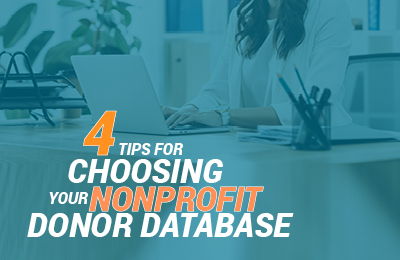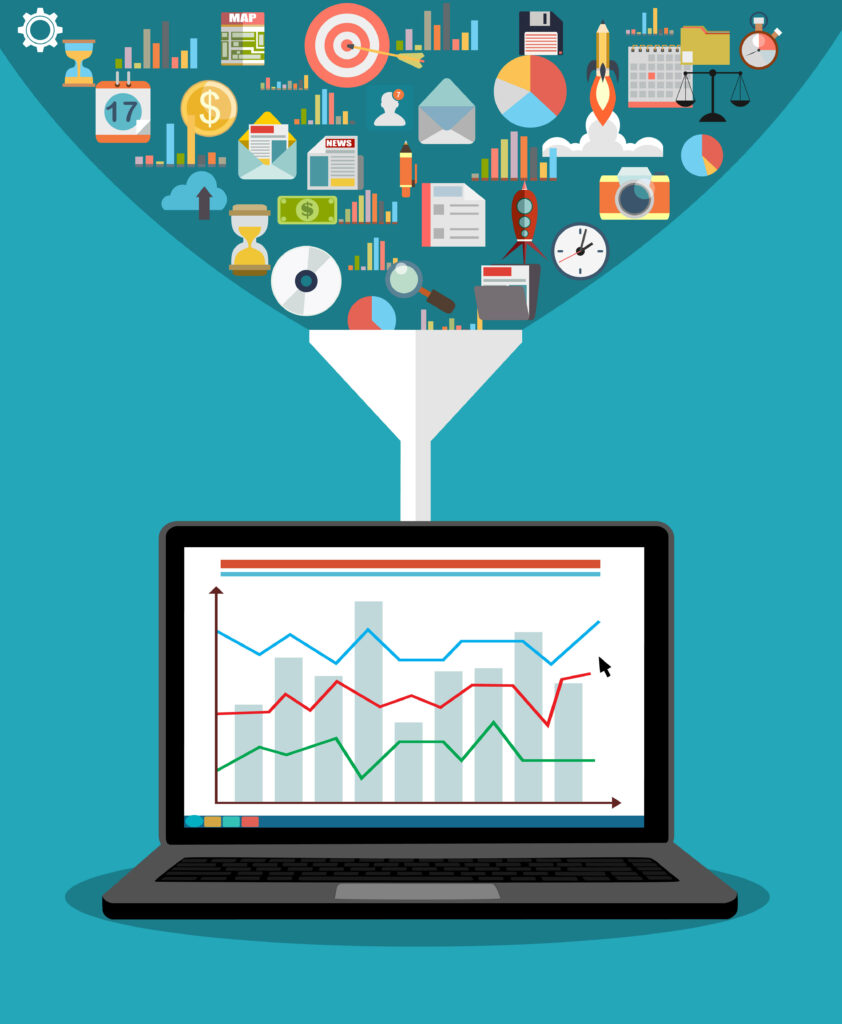
Choosing a donor database is a lot like hunting for the right romantic partner with online dating tools.
You are likely working from a long list of characteristics and browsing potential matches from brief descriptions and a few images. If you find something (or someone) that checks many of your boxes, you may schedule a demo—kind of like a first date. If the date goes well and the conditions are right, it could lead to wedding bells and a happy union between your sustainable nonprofit and a powerful CRM.
While choosing a donor management solution may not be an “until death do you part” level of commitment, but it’s still the first step in a long and successful relationship.
At SalsaLabs, we take on the role of matchmaker by helping nonprofits leverage powerful technology to meet their goals. To help you find a donor database that can be your team’s “other half,” we’ve compiled the following list of tips:
- Create a project team, plan, and timeline.
- Evaluate core functionality.
- Consider compatibility with the rest of your tech stack.
- Determine what additional features are essential for your organization.
The right donor database will support many aspects of your organization, from fundraising to volunteer management. So before tying the knot, make sure it’s meant to be!

Create a project team, plan, and timeline.
Selecting a software solution is no small undertaking. This is true for any type of software, but considering the immense impact that your supporter database has on your organization and mission, it’s especially important to follow an organized procedure.
Before diving into the decision-making process, you’ll probably have a general idea of the features your nonprofit is looking for—after all, there’s a reason you’re in the market for a donor database!
Establishing a plan upfront will give you clearer guidelines for evaluating the available databases and ultimately narrowing down your options to a few top contenders.
Assemble a team. Make sure you have all of the right people on board to make the decision. Depending on the size of your organization, you’ll want to invite anywhere from 2 to 10 people to weigh in on the decision. You’ll want to include the individuals who are directly impacted by the new system, the biggest consumers of information from the system, and anyone else who will have valuable input. The team reviewing the software will also help determine who will be using the software, which, depending on the system you choose, may factor into the budget decision.
Set a budget. Donor databases are built with a range of organizations in mind. Consider data like your number of donors, annual fundraising capacity, and major gift revenue to come up with a price point that makes sense for you. Be sure to establish this financial metric early on so you don’t waste time considering tools that are out of reach. However, if you’re a small nonprofit, you should choose a donor database that can scale up as your organization grows. Finally, it’s important to look for any additional customization or implementation costs when evaluating the price tag of each option.
Create a requirements document. You’ll want to develop a list of major functions and features that the donor database needs. As you create this document, try to limit yourself to the essentials and stay away from hyper-specific items. In general, it’s best practice to focus on what you need to accomplish rather than exactly how. The rest of this article will outline some characteristics you may want to consider.
As you go through this process, insist on defining your project plan in writing. This will ensure you stay on track and find a donor database that meets your needs and expectations.

Evaluate core functionality.
When considering expectations for your potential donor database, there are some core features you should look for.
You’ll want to keep the following core features in the back of your mind throughout the process, even if your primary focus is more specific:
Donor profiles and contact information. In addition to standard fields like name, address, and geographic location, look for a system that allows for custom fields. This will ensure you can record details that are specific to your organization’s audience; for instance, if you’re looking for a donor database for an animal shelter, you may want to record whether each supporter is a dog or cat person as well as the names of their current pets.
Analytics and reporting. The goal of your donor management software is to be able to store and use data effectively. While virtually all CRMs will offer reporting and visualization features, the complexity and flexibility of these can vary. This one place where your project team will have invaluable input since the people who need to access these reports should be represented.
Both of these functions will come standard in most of the donor databases available on the market, but with a wide range of variation. The size of your organization and the required detail level of your donor profiles will help you determine how you need these features to operate. Consider what your organization needs to accomplish to decide the scope of features you need from a solution.

Consider compatibility with the rest of your tech stack.
Your donor database should integrate with the other tools your nonprofit relies on. If it’s incompatible with the other elements in your existing nonprofit technology ecosystem, it may not be a good fit for your organization.
Your donor database should track every engagement metric you have with supporters. As such, you’ll want to consider the systems that track different types of engagement opportunities. For instance, if a supporter signs up to attend an event and donates to your most recent event, you’ll want to be sure all of these metrics are recorded and analyzed by your nonprofit. While some databases may have one or more of these functions built-in, others will require separate solutions.
Consider whether your organization uses the following tools, and if they are compatible with the donor database of your choice:
Fundraising software. Since one of the core purposes of your donor database is to inform your fundraising strategy, you’ll want a software solution that integrates seamlessly with your fundraising software. As this article explains, some fundraising systems pair well with CRMs, and some don’t, so you’ll need to consider the capabilities of your fundraising software as well.
Volunteer management software. If a supporter volunteers regularly with your nonprofit, you want to record that information alongside your other donor data. To avoid manual input, look for a donor database that syncs with your existing VMS.
Matching gift software. Corporate matching gifts can be a huge source of revenue for your organization if you know how to take advantage of the programs. According to Double the Donation, an estimated $4 – $7 billion in matching gift funds goes unclaimed every year. If you connect your donor database with matching gifts software, you’ll be better able to identify supporters who are eligible for matched contributions.
Event registration tools. Whether you’re hosting in-person, online, or hybrid events, you’ll want accurate records of every attendee. It’s helpful to have CRM and event solutions that are well-integrated. Then, you’ll be able to segment and target supporters more specifically based on whether or not they attended a past event.
Communications technology. Make sure your CRM can integrate with the tech you’re using to connect with supporters. This includes more traditional methods like email marketing as well as newer practices such as texting and social media outreach. If your communications platform and CRM are well-integrated, you’ll be able to automate outreach based on other interactions in the database, ultimately increasing supporter engagement.
When all of your supporter data can flow freely throughout your tech stack, you’ll be equipped to build well-rounded relationships with each donor. Take stock of your existing software systems and find a donor database that pairs well with each, then add that information to your requirements document.

Determine what additional features are essential for your organization.
Once you move past core features and software integrations, you’ll want to start on a list of features that are critical to your nonprofit’s operations. This list will be the most important part of your search, but it will also take the most thought to develop.
Consider what processes you have in place that are a drain on your team’s time, then look for a donor database that allows you to automate them or even skip steps completely.
Here are a few examples of tools from Salsa’s nonprofit CRM to give you some ideas of additional features that may save your team time:
Communication tools. Fundraising campaigns and other outreach efforts are more efficient when they can be accomplished directly from your donor database.
Automation and scheduling. Automated marketing tools allow you to contact the right supporter, with the right message, at the right time.
Comprehensive donation tracking. You’ll likely want a donor database that can manage both online and offline donations, avoiding manual input.
Smarter engagement strategies. Based on the interaction data you have available, your CRM can recommend optimized engagement methods. These can even be queued up automatically with automation tools.
Of course, your organization’s needs are unique, so your project team should brainstorm and collaborate to determine your must-have features and add them to your requirements document.
With so many options available, choosing a donor database to meet your needs can feel like an arduous and overwhelming process. A CRM solution will help you get organized and better engage your supporters, so it’s wise to invest the time and energy upfront so you can reap the benefits for years to come. With these strategies in mind, you and your donor management software will be able to live happily ever after. Good luck!
About the Author: Gerard Tonti

Gerard Tonti is the Senior Creative Developer at Salsa Labs, the premier fundraising software company for growth-focused nonprofits.
Gerard’s marketing focus on content creation, conversion optimization and modern marketing technology helps him coach nonprofit development teams on digital fundraising best practices.


